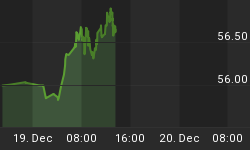
![]() Larger Image - Charts created using Omega TradeStation 2000i. Chart data supplied by Dial Data
Larger Image - Charts created using Omega TradeStation 2000i. Chart data supplied by Dial Data
The S&P 500 has soared to new all-time highs leaving most everyone in a state of giddiness. The NASDAQ and the Dow Jones Industrials (DJI) have gone along for the ride. The Dow Jones Transportation (DJT) remains, for the moment at least, just below its all-time highs. With the giddiness of new all-time highs, however, comes a note of caution. The giddiness may be short-lived.
The monthly chart of the S&P 500 is potentially very bearish. The S&P 500 is forming what appears as a huge ascending wedge triangle. The top channel is formed by joining the low of July 2002 with the higher low of February 2003. A couple of things stand out with the channel line. First, the line appears to have acted as the breakdown zone for the financial crash of 2008. The second thing is that the 2011 high touched up close to the channel but failed to breakout over. A sharp correction followed.
The lower channel is formed from the low of March 2009 and up through the low of October 2011. The low of November 2012 tested down towards the line but failed to break it. The current market is testing the top of the channel. Wedge triangles are not unusual. This one just happens to be forming on a long-term chart. The breakdown zone is currently near 1,430 and the 18-month moving average. A breakdown of the wedge triangle potentially implies objectives that could take the S&P 500 in theory all the way back to its 2009 lows (666). Minimum objectives could be at least the halfway point at around 1,130.
Note the indicators as well. Both the MACD indicator and the RSI indicator are making lower highs even as the S&P 500 moves to new nominal highs. The rally of 2002-2007 took 5 years before the S&P 500 returned to its 2000 highs. This time around, the rally took a less time as the market is just over four years from its March 2009 low.
So what is going on? The market was up sharply in January and February. Mutual funds in the US need to be fully invested especially when a quarter end is coming up as it was in March. It is also year-end for a number of funds as well as some hedge funds. Therefore, a market closing higher into the end of March means big performance fees. The early part of April can bring further buying. The funds are usually probing higher to see if there any sellers. As there is incentive for the funds to keep the "party" going for a while so that they can sell to late comers. Then when the market tops and falls, they all announce "Sell in May, and go away". It is not unusual for markets to have tops in April and October.
There remains a potential objective for the S&P 500 up to as high as 1,605 or it could be up to 1,620. But at this point there are no higher objectives. The market is being driven by QE in the US, Japan and even in Europe as the Euro zone has come back from the precipice of Cyprus by tapping into depositors funds. Depositor's funds are now at risk in the western economies as it has been revealed that agreements are in place to use depositor fund to bail-in collapsing banks rather than bailouts from the taxpayer.
If the market were to break sometime this month, the breakdown could be similar to what occurred in July 2007. The market fall in July 2007 was triggered by the first breaking news of the sub-prime meltdown when Bear Stearns announced the closing of some funds. Following the first break, it is not unusual to see the market rebound back. The market could even make new highs as was seen in October 2007.
The first breakdown point of note for the S&P 500 is at 1,535. The low last week was at 1,539. As the S&P 500 climbs in the wedge triangle, time is running out as the wedge narrows. Rather than it being "up, up and away" investor's should heed the signs as it might well be an "or".
















